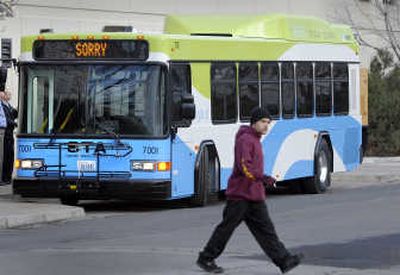New year will bring clean-running hybrid buses to STA routes

Art Blodgett gets to drive Spokane Transit into the future.
Blodgett is one of several drivers trained to operate STA’s three new hybrid buses. The hybrids will begin cruising around town early next year.
“Green is the future,” he said.
The $572,000 buses are more about using less fuel and creating less pollution than saving money, said STA CEO Susan Meyer.
STA probably won’t recoup the $211,000 price difference between each hybrid and its fully diesel counterpart unless fuel prices increase dramatically over the expected 15-year life of each hybrid.
At today’s diesel prices, each hybrid will save $90,000 in fuel costs over 12 years, Meyer said. If prices go up 80 cents per gallon, that savings would be $128,000.
In 12 years, the buses will produce 352 fewer tons of carbon emissions than fully diesel buses.
The buses will run on a variety of routes.
Unlike in hybrid cars, the diesel engine is always running to power heating and cooling and several other systems. At low speeds, however, the electric battery, which is recharged during braking, is used to power the motor.
Riders will notice that the buses are quieter at these slow speeds, making for a more pleasant ride.
New commuter route
North Spokane residents who have jealously looked at commuter routes connecting Spokane Valley, Liberty Lake and Cheney to downtown will get their own limited-stop route on Jan. 21.
The North Express route will run between the Hastings Park and Ride near Whitworth University and the STA Plaza downtown, using Monroe Street for the bulk of the trip.
The bus will make just three stops in between: at Francis, Wellesley and Broadway.
Buses along the route will be labeled “Commuter Express” so that people at other stops aren’t confused about why the bus is passing them by, said STA spokeswoman Molly Myers.
The trip will take about 33 minutes.
Buses will run every 15 minutes from about 5 a.m. and 9 a.m. and again from 3 p.m. to 7:45 p.m. Schedules will soon be available at the plaza and STA offices.
Hands-free countdown
There’s still time to ask Santa to leave a Bluetooth headset in your stocking.
Using your hands to hold a cell phone to your ear while driving becomes illegal in Washington come January.
The law was changed to improve safety but still allows people to talk on their phones while driving if they use a headset and leave the phone on the seat or dash.
How much it will reduce crashes remains to be seen. Most studies on cell-phone use while driving have shown that people are equally distracted and equally prone to making driving mistakes when using a hands-free device as with the phone to their ear.
Worst winter drivers
After last week’s recitation of several types of bad winter drivers, readers sent in some additional suggestions.
Tailgating Guy: This driver, suggested by several people, is so important and in such a hurry that he drives so close you can’t see his headlights. Never mind that you might have to stop suddenly.
Overly worried driver: Hugh Imhof described this driver as the one who goes much slower than necessary even as a line of cars builds behind him or her. “Inevitably someone loses patience and passes at the wrong time … resulting in a wreck.”
Barker Road Bridge restrictions
Passenger vehicles remain unaffected, but some heavy trucks can no longer use the Barker Road Bridge spanning the Spokane River between Interstate 90 and Trent.
Single trucks are now limited to 25 tons. A truck and trailer can weight 35 tons.
The bridge is scheduled to be rebuilt this spring at which time it will temporarily be closed to